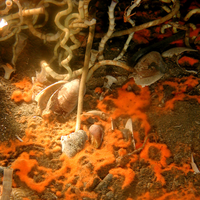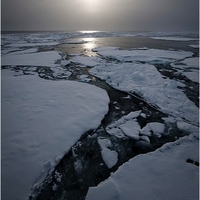By Angela Sherry. 7th June 2011.
ocean
Methane and the Seafloor – the Strange World of Cold Seeps
12th September 2013.
A recent paper in Nature Geoscience has reviewed methane dynamics on the ocean floor around cold seeps. Cold seeps (or cold vents) are caused by tectonic activity and are quite different to the better known hydrothermal vents, although both ecosystems rely on chemosynthesis, not photosynthesis. Numerous extremophile species colonise these habitats, including deep sea mussels and tubeworms. Various types of cold seeps exist, such as pockmarks, mud volcanoes and subsurface gas chimneys, and they are frequently associated with gas hydrates.
Anaerobic oxidation of methane (AOM) is very high in these systems, which creates end-products of sulphide and dissolved inorganic carbon (DIC), leading to the build-up of carbonate structures. As well as AOM, aerobic respiration of methane takes place on surface sediments, or via methanotrophs living in symbiosis with invertebrates.
Usually methane flux on the sea bed decreases as water depth increases, but around cold seeps (which can be found at water depths of up to 3000 m) there is no trend, and this is caused by the differences in geology between seeps. Dissolved methane fluxes at cold seeps have been found to range from 3-1226 mmol CH4 m-2 d-1 but the authors point out that these are complex ecosystems that exhibit considerable spatial and temporal variations in flux. Additionally, gaseous methane is released, and larger amounts of this can escape consumption at the seep. The total flux (dissolved and gaseous) that enters the hydrosphere will either be consumed within the water column or released into the atmosphere. The authors’ calculation is that this total amounts to an annual figure of 0.02 Gt C.
As a conclusion, the paper calls for more research into these deep-sea systems due to their importance in methane cycling as well as their biological richness, and the fact that they are often found in areas prime for future industrial gas hydrate extraction.
Reference: Boetius, A., Wenzhöfer, F. 2013. Seafloor oxygen consumption fuelled by methane from cold seeps. Nature Geoscience, 6, 725-735.
Photo by Ian MacDonald. An aggregation of Lamellibrachia luymesi in the Gulf of Mexico. Source: Tubeworm May Live Longer by Cycling Its Sulfur Downward. PLoS Biol 3/3/2005: e108. http://dx.doi.org/10.1371/journal.pbio.0030108
New Arctic Methane Source?
16th May 2012.
A new set of airborne observations has revealed high methane concentrations in the atmosphere above the Arctic Ocean. The concentration of methane is correlated with open leads (cracks) in the sea ice and regions with fractional ice cover (Kort et al., 2012). In the recently published Nature Geoscience paper, the authors suggest that the methane derives from a previously under-recognised source, aerated surface ocean waters.
Eric Kort, who led the study, told MethaneNet that the finding was “unexpected”. He explained how the work came about. “The observations were made as part of the HIAPER Pole-to-Pole Observations (HIPPO) campaign, on which we made airborne observations from 67S to 85N. Our attention was drawn to the Arctic methane question by an observation made onboard the aircraft. We noticed that on many profiles, as we descended near the ice-ocean surface, our instruments recorded increases in methane, with no coincident increase in carbon monoxide. This feature piqued our curiosity, and led to the analysis presented in our paper.”
The data were collected using instruments mounted onboard the NSF/NCAR Gulfstream V. During the five flights, from January 2009 to April 2010, methane, carbon monoxide, ozone and water vapour concentrations were measured at heights ranging from 0.15 – 8.5 km. Using the ancillary gas measurements, the authors were able to rule out biomass burning and oil and gas industry operations as the methane source.
Initial estimates suggest a flux rate of 0.5 – 8.0 mg CH4 d-1 m-2 from this newly revealed source. The research prompts many questions. How might future changes in sea ice cover impact the fluxes? Is there a connection with other recently reported Arctic methane sources such as degradation of subsea permafrost on the eastern Siberian shelf. How exactly is this methane produced?
Eric Kort recognizes that more information is needed, saying to MethaneNet, “hopefully our work motivates further study on methane emissions from Arctic Ocean”.
Reference:
Kort, E.A., Wofsy, S.C.,Daube, B.C., Diao, M., Elkins, J.W., Gao, R.S., Hintsta, E.J., Hurst, D.F., Jiminez, R., Moore, F.L., Spackman, J.R., and Zondlo, M.A. (2012), Atmospheric observations of Arctic Ocean methane emissions up to 82°N. Nature Geoscience, 5, 318-321.
Image of Arctic sea ice by Stefan Cook @ flickr.com


